Choice of Liquid Electrolytes In Anode Free Lithium Metal Batteries and its Impact on Lithium Morphology
Bachelor thesis
Permanent lenke
https://hdl.handle.net/11250/3002456Utgivelsesdato
2022Metadata
Vis full innførselSamlinger
- Institutt for kjemi [1390]
Sammendrag
En økning i etterspørser for energitette batterier fra elektriske kjøretøy har gitt insentiv for å utvikle ny teknologi for energitett lagring av elektrisitet. En teknologi som har muligheten til å fylle etterspørselen er anodefrie litium metal batterier. Mangelen på en anodemateriale før lading gir AFLMBs større energitetthet en litium ione batterier, men fører også til redusert livstid og sikkerhetsproblemer. I denne oppgaven vil dagens strategier of utfordringer rundt AFLMB bli diskutert, med et fokus på valget av elektrolytt. Bruken av et eter basert elektrolytt med høy konsentrasjon av dobbelsalt ga de beste resultatene. Levetiden og sikkerheten til AFLMB er fortsatt for dårlig for praktisk bruk, selv med en optimalisert elektrolytt. AFLMB viser stort potensiale for utbrett adopsjon, men videre forskning på å stabilisere deponert litium er nødvendig for å nå denne adopsjonen. An increase in demand for energy dense batteries coming from electric vehicle has created anincentive to develop new technology for energy dense electricity storage. One technology thathas the possibility to fulfill these demands is anode free lithium metal batteries (AFLMBs).The lack of an initial anode material gives AFLMBs an increased energy density over lithiumion batteries, but also results in AFLMBs having low cycle life alongside some safety concerns.In this thesis the current strategies and challenges of AFLMBs are discussed, with a focuson the choice of electrolyte. The use of ether based solvents with a high dual lithium saltconcentration were found to give the best performance. The cycle life and safety of the batteryremains too poor for practical applications, even with the optimized electrolyte. AFLMBsshow great promise and may show widespread adoption in the future, but more research intostabilizing the deposited lithium’s morphology is needed to see this adoption
